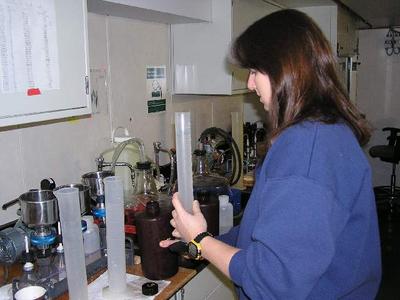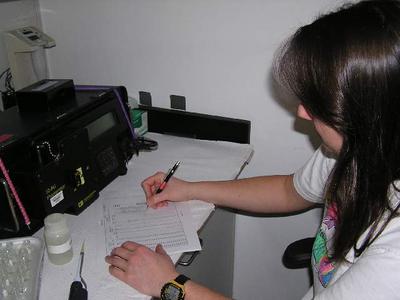16 August, 2003
The hunt is on. The scent of the prey is in the air. And the biologists are working themselves into a frenzy. The quarry? Phytoplankton.
Phytoplanktons are tiny microscopic plants that live in the ocean. Many are diatoms, a kind of single-cell algae that are often connected together in long chains. Others are called dinoflagellates which have two tails. Cyanobacteria too, which are so small that they are hardly even there. Although they come in different shapes and sizes, all phytoplankton have a greenish color. Similar to green plants on land, these photosynthetic organisms use chlorophyll to capture the sun's energy to live. Chlorophyll is used by all plants to fuse water molecules and carbon dioxide into carbohydrates, or plant food. Zooplankton, certain fish, and even some large whales eat these drifting oceanic plants to consume these same carbohydrates. As such, phytoplanktons form the foundation of the food chain throughout the world's oceans.
As you might expect, it's not easy to see these small plants. The phytoplankton biologists, however, are very good hunters and make finding their prey look easy. First, you need to know where to search. Because sunlight is most abundant at and near the surface, phytoplankton remain near the top of the water column, usually within the upper 25 meters in these chilly waters.
Now the tricky part, as Dr. Dean Stockwell of the University of Alaska at Fairbanks explains: "Chlorophyll is a fluorescent molecule and can be determined by fluorometry. By filtering these organisms onto filter paper and then extracting the chlorophyll in a solvent, we can estimate the amount of chlorophyll throughout the water column. Horizontal vertical distributions of phytoplankton biomass can then be mapped showing areas of enhanced productivity. These and areas of increased plant productivity are closely associated with elevated animal numbers."
Another phytoplankton hunter, Stephanie Moreland of the University of Alaska's Seward Marine Center, demonstrated the methodical process of filtering the numerous water samples and collecting the tiny plants on filter paper in the ship's Biology Lab. The most exciting part for me involved watching the last portion of the water sample disappear through the filter paper since every so often one of the bioluminescent phytoplankton would flash a pale blue light as they hit the paper barrier. Stephanie described it as their "last gasp." After adding solvent to the plankton residue left behind on some previously collected filters, Stephanie prepares the fluorometer that will measure the chlorophyll content in the samples. Stephanie makes it all look easy, but she is quick to observe, "I've had a lot of practice as we'll have processed over 2000 plankton-stained filters before the end of the cruise."
Dean went on to describe some of the things that they are looking for: "Marine phytoplankton have rapid life cycles and are instrumental players in the atmospheric cycling of oxygen and carbon dioxide. Some of the things we are looking for are seasonal differences, vertical distributions (i.e., where in the water column are we seeking maximum abundances), horizontal distributions (i.e., how is the biomass distributed over the shelf into the deep basin; are there differences?), and the biomass distribution among size classes (i.e. is the chlorophyll in the big phytoplankton greater than 20 microns, or is it in the small plankton which is less than 20 or 5 microns?)."
But the research that Dean and Stephanie do involves much more than counting numbers and charting distributions of phytoplankton. Since populations of these microscopic plants respond rapidly to changes in their environment, it's possible that marine phytoplankton can influence global change. Phytoplankton use carbon dioxide for photosynthesis. Large populations of phytoplankton, for example, could pull this greenhouse gas from the atmosphere; and thus, lower the average temperature around the globe. Or for that matter, just the opposite could occur, and the world would become warmer. Spotting these phytoplankton population changes is only possible if scientists like Dean and Stephanie continue to determine the oceans' chlorophyll content. And as long as the thrill of the hunt is still there, I suspect that they always will.

1. Phytoplankton hunters Dr. Dean Stockwell and Stephanie Moreland in the Palmer's Bio Lab.

2. Dean Stockwell taking a chlorophyll sample from the rosette in the Baltic Room. (Note the blurry hand action as Dean has to move fast to catch phytoplankton.)

3. Stephanie Moreland filtering phytoplankton in the Bio Lab.

4. Stephanie Moreland measuring the chlorophyll amount in a sample with the ship's fluorometer.
Contact the TEA in the field at
.
If you cannot connect through your browser, copy the
TEA's e-mail address in the "To:" line of
your favorite e-mail package.
|
